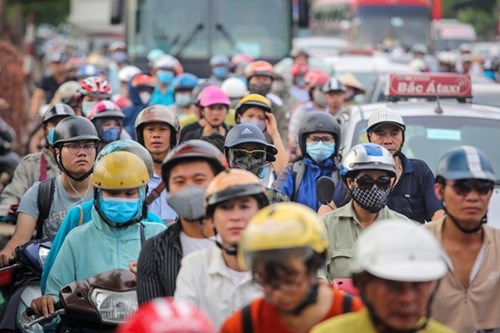At the event, Deputy Director of the city’s Transport Department Ngo Manh Tuan listed the many projects undertaken by Hanoi authorities in the recent past to ease traffic jams in the city, including 8 flyovers at key intersections and three belt roads.
The city is also investing in radial roads towards step by step completing the transport infrastructure network.
    |
 |
|
Traffic jam continues to be a big issue for Hanoi despite heavy investment in transport infrastructure in the city |
The Transport Ministry and the city are joining hands in carrying out several urban railway projects, such as the Cat Linh-Ha Dong (Route 2A) and the Nhon-Hanoi Station (Route 3) routes. Preparations are underway for the implementation of the railway routes No. 4 and 5, and the extension of Route 2 and 3.
In addition, a number of big bridges around the city have been completed, for example the Nhat Tan across the Red River, the Dong Tru spanning Duong River and most recently the Van Lang connecting Hanoi and adjacent Phu Tho province across the Red River.
“Those projects have contributed considerably to reducing traffic jams inside the city, and Hanoi will continue to push ahead with projects under its master plan on transport infrastructure development, so as to increase connectivity and ease pressure on belt and radial roads,” said Tuan.
In parallel with investment in infrastructure, the city is implementing other measures to tackle traffic jams, one of which is to increase the quantity of public transport means such as buses and quality of public transport service to attract more commuters. The organisation of traffic flows is constantly reviewed to timely adjust traffic control at “hot spot” of traffic jams.
At the same time, communications activities along with frequent patrol and stricter punishment are being stepped up to enhance road users’ compliance with traffic rules.
The serious consequences of traffic jams were the concern of many participants at the workshop.
According to Pham Hoai Chung, director of the urban and suburban transport centre under the Institute of Transport Strategy and Development, traffic jam has great socio-economic impacts. He said some research projects have shown the problem caused losses of between 1-1.2 billion USD each year to Hanoi.
He said more than 1 million working hours each year are wasted due to traffic congestion, while residents’ health is threatened by air pollution. Traffic problems also affect the investment environment and other fields of social development.
Deputy head of the Traffic Police Section under Hanoi Public Security Department Nguyen Manh Hung said Hanoi’s transport infrastructure is overloaded, with some works operating at six to seven times of capacity. Moreover, the actual percentage of land designated for transport use in the country is only 8.65 percent of the total land area, while the percentage stipulated by law is 16-26 percent in urban areas, he said, adding that the rates in developed countries range from 20-25 percent.
Therefore, overloading is inevitable, he said.
Hung pointed to other importance causes of transport congestion which is the high density of high-rise apartment buildings in some areas and the rapid increase in the number of private transport means.
Dr Tran Huu Minh, deputy chief of the National Committee for Transport Safety, said the city is in urgent need of safe, environmentally-friendly and convenient public transport means.
Deputy director of Hanoi Transport Department Ngo Manh Tuan reported that his department has been applying information technology in traffic management. A smart traffic control centre has been established to regulate traffic flow and timely address congestions.
He informed that the city is accelerating the implementation of the Government’s policy to relocate offices, schools and a number of hospitals from the inner city of Hanoi.
Mentioning a proposal on collecting fees for private transport means when entering the inner city, Tuan said the department has submitted its scheme on how to carry out the mechanism. The scheme, which by now has been submitted to the Prime Minister for guidance, includes imposing road fees on vehicles in areas with high traffic flow.
Source: VNA